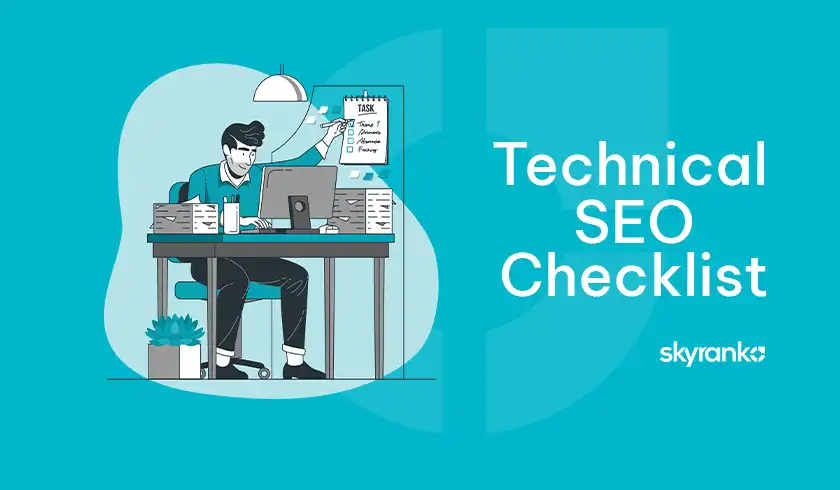Technical SEO refers to the behind-the-scenes optimization techniques that ensure search engines can seamlessly crawl, index, and understand your website’s content. It’s the foundation upon which your entire SEO strategy rests, laying the groundwork for improved visibility, user experience, and ultimately, higher search rankings and increased organic traffic.
This article will discuss all the essential technical SEO checklists that you should abide by in 2024 and beyond to help you secure a prominent position in SERPs. Let’s begin.
What Are The Benefits of Technical SEO?
The benefits of a solid technical SEO strategy are multifaceted:
- Maximized Crawlability: By optimizing your website’s structure and providing clear signals to search engines, you guarantee that your content is easily discoverable and indexable, increasing your chances of ranking well.
- Exceptional User Experience: Technical SEO best practices, such as optimizing for Core Web Vitals and ensuring mobile-friendliness, directly contribute to a seamless and engaging user experience across all devices, fostering customer satisfaction and loyalty.
- Elevated Organic Traffic and Conversions: A technically sound website, coupled with compelling content and effective on-page optimization, can significantly boost your search visibility and drive more targeted traffic to your site, ultimately leading to higher conversion rates and better business outcomes.
Technical SEO Checklist #1: Building a Strong Foundation

Website Crawlability and Architecture Checklist
Your technical SEO journey begins with establishing a robust foundation for your website. Conducting a comprehensive website audit using industry-leading tools like Google Search Console, Screaming Frog, and DeepCrawl is crucial for identifying any underlying issues that might hinder search engine crawlability and content discoverability.
Ensure Website Security
Ensuring website security with HTTPS implementation is no longer optional; it’s a must-have for user trust, data privacy, and potential ranking benefits. Addressing any mixed content issues (resources loaded over HTTP on an HTTPS page) is equally essential to maintaining a secure browsing experience.
Achieve Mobile-Friendliness
As Google continues to prioritize mobile-first indexing, achieving mobile-friendliness across all devices is paramount. Your website’s design, content, and functionality should be optimized for seamless mobile experiences, ensuring no user is left behind.
Control search engine crawling
Configuring your robots.txt file correctly is vital for controlling search engine crawling and preventing unnecessary resource consumption. Additionally, creating and submitting an XML sitemap to search engines can guide them to your website’s content, ensuring efficient indexing and discoverability.
| We understand that implementing these strategies can be a daunting task, especially for those with limited technical resources or expertise.That’s why at Skyranko, we specialize in helping businesses like yours navigate the complexities of technical SEO to ensure that your website is fully optimized for search engine visibility, user experience, and long-term success. |
Technical SEO Checklist #2: Enhancing Website Architecture and User Experience

Site Architecture and User Experience
Building a user-friendly and SEO-optimized site architecture with clear navigation and logical hierarchy is essential for both users and search engines. This involves structuring your content in a way that facilitates easy navigation and discovery, ensuring that no pages are orphaned or buried too deep within your website.
Optimize for Core Web Vitals
Improving Core Web Vitals (Largest Contentful Paint, First Input Delay, and Cumulative Layout Shift) is critical for delivering a smooth and responsive user experience. Optimizing for these metrics can positively impact your search rankings and user engagement, as search engines increasingly prioritize user experience signals.
Identify and Fix Broken Links
Identifying and fixing broken links, redirects, and other crawl errors is crucial for maintaining a healthy website. Broken links can lead to poor user experiences and potentially impact your site’s crawlability and indexation, hindering your SEO efforts.
Implement Schema.org
Implementing structured data markup (schema.org) can enhance your search result snippets, providing users with rich, informative previews that can improve click-through rates and engagement.
Technical SEO Checklist #3: Optimizing Content and Metadata

Content and Metadata Optimization
Crafting SEO-friendly and descriptive URLs with target keywords not only aids in user understanding but also reinforces relevance signals for search engines. Well-optimized URLs can contribute to higher click-through rates and better content discoverability, making them a worthwhile investment.
Optimize Title Tags and Meta Descriptions
Optimizing title tags and meta descriptions is essential for improved click-through rates from search engine result pages (SERPs). Compelling and keyword-rich titles and descriptions can entice users to click through to your website, increasing your chances of capturing their attention and driving traffic.
Leverage Header Tags
Leveraging header tags (H1, H2, etc.) correctly can improve the structure and readability of your content while reinforcing topical relevance for search engines. This not only enhances the user experience but also aids in better understanding and ranking your content.
Optimize Alt Text
Implementing image optimization techniques, such as descriptive alt text, optimized file names, and compression, can enhance user experiences, improve page load times, and provide additional opportunities for search engine visibility, making your content more accessible and engaging.
Other Advanced Technical SEO Considerations
Implement Hreflang Tag
For websites targeting multiple languages or regions, implementing the hreflang tag is crucial for effective international SEO. This tag specifies the language and geographical targeting of your website’s content, ensuring that search engines serve the appropriate version to users, enhancing relevance and user satisfaction.
Set Up Geotargeting
Geotargeting setup in Google Search Console can further enhance local search optimization by tailoring your website’s content and settings for specific regions or locations, increasing your visibility in targeted areas.
Optimize for E-Commerce
E-commerce websites have unique technical SEO considerations, such as implementing product schema markup for enhanced search result visibility and optimizing faceted navigation for improved crawlability and indexation, ensuring a seamless shopping experience for users.
Optimize for User Experience Signals
As search engines continue to prioritize user experience, optimizing for user experience signals beyond Core Web Vitals is becoming increasingly important. Factors such as time spent on page, bounce rate, and user engagement metrics may play a more significant role in determining relevance and ranking potential, so monitoring and optimizing for these signals is crucial.
Frequently Asked Questions (FAQs)
How can I ensure my technical SEO efforts are working?
Regularly monitoring your website’s performance using tools like Google Search Console, analytics platforms, and crawling software is crucial for evaluating the effectiveness of your technical SEO efforts. Keep an eye on metrics like crawl errors, indexation rates, page speed, and overall organic traffic and rankings to gauge the impact of your optimizations.
What role does site speed play in technical SEO?
Site speed is a critical factor in technical SEO, as it directly impacts user experience and search engine crawlability. Slow-loading websites can lead to higher bounce rates, and frustrating users and search engines alike. Optimizing for site speed by minimizing HTTP requests, compressing files, and implementing techniques like caching and code minification can significantly improve your technical SEO performance.
How often should I update my XML sitemap?
It’s generally recommended to update your XML sitemap whenever significant changes are made to your website, such as adding or removing pages, or updating existing content. Some experts suggest updating your sitemap at least once a month or more frequently for larger, rapidly changing websites to ensure search engines have the most up-to-date information about your site’s content.
